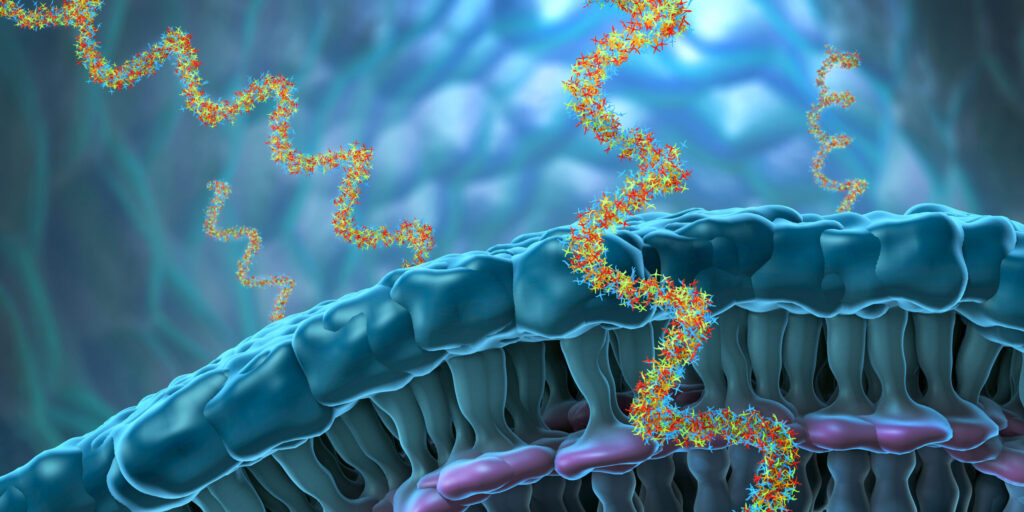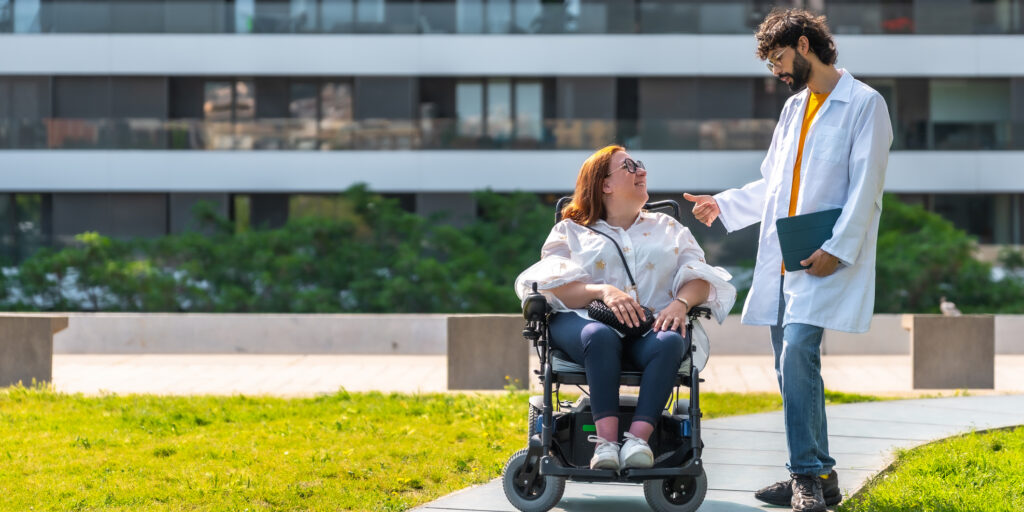
Simply Stated: Updates in SELENON-Related Myopathy
By Sujatha Gurunathan | Tuesday, May 7, 2024
5 Second Summary
“Simply Stated” is a Quest column designed to explain some terms and basic facts about neuromuscular diseases.
Find more at Mdaquest.org/tag/simply-stated
SELENON (SEPN1)-related myopathy (SELENON-RM) is a rare congenital neuromuscular condition characterized by slowly progressive axial (trunk and head) muscle weakness, early-onset rigidity of the spine, scoliosis (sideways curve of the spine), and respiratory insufficiency (breathing impairment). One study estimated that SELENON-RM affects about 0.5 in 100,000 people.
Symptoms of SELENON-RM
SELENON-RM is an inherited condition that becomes apparent at birth (congenital). The first symptoms that children born with SELENON-RM may experience are weak muscle tone and/or floppiness of the trunk and neck. They may also exhibit a delay in motor skills such as crawling or walking. As they get older, most affected people will achieve the ability to walk, but may experience difficulty due to spine rigidity and scoliosis. Many will also experience respiratory insufficiency, leading to the need for night-time non-invasive ventilation for breathing support. Common symptoms that people with SELENON-RM may experience include:
- Rigid spine
- Scoliosis
- Muscle weakness
- Hypotonia (low muscle tone)
- Limited flexion (range of motion)
- Poor head control
- Difficulty gaining weight
- Restrictive lung capacity (reduced volume of air inhaled and exhaled)
- Nocturnal hyperventilation (night-time shallow breathing)
For more information about the signs, symptoms, and prognosis of SELENON-RM, a case series profiling people with the disease can be found from Villar-Quiles, et al.
Cause of SELENON-RM
SELENON-RM is caused by mutations in the SELENON (SEPN1) gene, which encodes production of a protein known as selenoprotein N1. Genetic changes that cause SELENON-RM are inherited in an autosomal recessive pattern, which means that two copies of the defective gene (one from each parent) are required to cause the disease.
The exact function of selenoprotein N1 is not known, but it belongs to a family of proteins that protect cells against damage caused by free radical molecules (oxidative stress). It is likely that selenoprotein N1 also protects against oxidative stress. Notably, SELENON-RM shares similar features with other conditions that involve oxidative stress, such as the mitochondrial diseases.
Selenoprotein N1 is found in many tissues in the body before birth and may be involved in the formation of muscle tissues (myogenesis). It is also active in adult tissues, though at lower levels. Within cells, selenoprotein N1 is found on a structure known as the endoplasmic reticulum (ER), and is thought to sense and regulate the balance of calcium in the cell. Calcium plays an important role in triggering muscle contractions. This may explain why the loss of selenoprotin N1 in people with SELENON-RM affects muscle function.
Diagnosis of SELENON-RM
Though some symptoms of SELENON-RM overlap with those of other congenital myopathies, the condition has key clinical features (e.g., weak axial muscles, respiratory insufficiency, retention of walking ability, etc.) that may distinguish it on a clinical exam. Follow-up genetic testing can help establish a definitive diagnosis. In some cases, testing may only successfully identify one copy of the mutation, but combined with clinical presentation, it can confirm the diagnosis of SELENON-RM.
Management of SELENON-RM
While there are currently no approved treatments for SELENON-RM, proactive surveillance and care are critical to managing symptoms and disease progression, avoiding severe illness or hospitalization, and improving an affected individual’s overall health and quality of life. This includes multidisciplinary care by specialists in neurology, pulmonary medicine, cardiology, nutrition, orthopedics, occupational, physical and speech therapy, as well as potentially other specialties. It is important to begin breathing function surveillance by the age of 5 years old (if not earlier), which includes baseline pulmonary function testing and sleep study, with regular follow-ups to detect early signs of breathing decline. Close monitoring of feeding and nutrition with the potential for early intervention is also critical to overall health.
Care recommendations to guide physicians in evidence-based treatment of people living with congenital myopathies, including SELENON-RM, were last developed by the International Committee on Standard of Care for Congenital Myopathies in March 2012.
Evolving research and treatment landscape
While the current standard of care is proactive symptom management, research advances and the promise of therapeutic development on the horizon offer hope for people living with SELENON-RM. Understanding of the mechanisms contributing to SELENON-RM is guiding preclinical development of new treatment strategies. For example, researchers are studying strategies to counter the damaging effects of oxidative stress as a therapy for SELENON-RM. A notable researcher in the SELENON-RM space, whose work has been previously funded by MDA, is Dr. Alan Beggs. An overview of SELENON-RM research curated by Dr. Beggs’s laboratory can be found here.
Observational studies and patient registry opportunities are also ongoing to better understand the disease course of SELENON-RM and identify outcome measures that may be used for future clinical trials. Opportunities that are currently enrolling affected individuals include:
· Congenital Muscle Disease International Registry (Cure CMD)
· A 5-year Natural History Study in LAMA2-related Muscular Dystrophy and SELENON-related Myopathy (Radboud University Medical Center)
To learn more about research and clinical study opportunities in SELENON-RM, visit clinicaltrials.gov and search for “SELENON-related myopathy” in the condition or disease field.
Ongoing preclinical and clinical studies will help researchers to better understand SELENON-RM, identify targets for therapeutic intervention, and test potential therapies. They will lay the groundwork for future clinical trials, improving prospects for better disease management for people living with SELENON-RM.
MDA’s Resource Center provides support, guidance, and resources for patients and families, including information about SELENON-related myopathy, open clinical trials, and other services. Contact the MDA Resource Center at 1-833-ASK-MDA1 or ResourceCenter@mdausa.org.
Other organizations serving the SELENON-RM community include:
Cure CMD curecmd.org
Struggle Against Muscular Dystrophy (UK) helpsam.info
Olivia Bloomfield Foundation oliviabloomfieldfoundation.org
CMD Turkey cmdtr.com
AFM Telethon
Muscular Dystrophy UK
Muscular Dystrophy Canada
Next Steps and Useful Resources
- For more information about the signs, symptoms, and prognosis of SELENON-RM, a case series profiling people with the disease can be found from Villar-Quiles, et al.
- An overview of SELENON-RM research curated by Dr. Beggs’s laboratory can be found here.
- To learn more about research and clinical study opportunities in SELENON-RM, visit clinicaltrials.gov and search for “SELENON-related myopathy” in the condition or disease field.
- Congenital Muscle Disease International Registry (Cure CMD)
- A 5-year Natural History Study in LAMA2-related Muscular Dystrophy and SELENON-related Myopathy (Radboud University Medical Center)
- MDA’s Resource Center provides support, guidance, and resources for patients and families, including information about SELENON-related myopathy, open clinical trials, and other services. Contact the MDA Resource Center at 1-833-ASK-MDA1 or ResourceCenter@mdausa.org.
- Stay up-to-date on Quest content! Subscribe to Quest Magazine and Newsletter.
TAGS: Clinical Trials, Community, Drug Development, Healthcare, Innovation, MDA Care Centers, MDA Resource Center, Research, Research Advances, Resources, Simply Stated
TYPE: Blog Post
Disclaimer: No content on this site should ever be used as a substitute for direct medical advice from your doctor or other qualified clinician.




